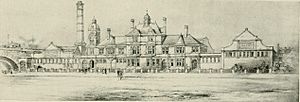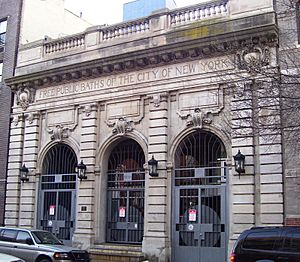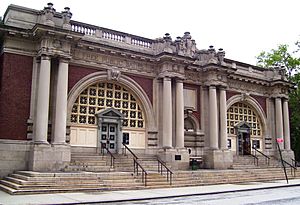Simon Baruch facts for kids
Quick facts for kids
Simon Baruch
|
|
|---|---|
 |
|
| Born | July 29, 1840 Schwersenz, Prussia
|
| Died | June 3, 1921 (aged 80) New York City, US
|
| Education |
|
| Occupation | Physician, scholar |
| Spouse(s) |
Isabelle Wolfe
(m. 1867) |
| Children | 4, including Bernard M. Baruch, Herman B. Baruch |
Simon Baruch (July 29, 1840 – June 3, 1921) was a doctor and a smart thinker. He was best known for pushing for public bathhouses in cities across the United States. He believed these baths were super important for keeping people healthy.
Contents
Early Life and Education
Simon Baruch was born in Schwersenz, a place in what was then called Prussia (now part of Poland). His parents, Bernard and Theresa, were Jewish. When he was 15, in 1855, he moved to South Carolina in America. He lived with the Manus Baum family and worked as a bookkeeper.
In 1859, Simon started studying medicine. He went to classes at the Medical College of the State of South Carolina. Then, he enrolled at the Medical College of Virginia (MCV) in Richmond, Virginia. He earned his medical degree there in 1862.
A Doctor in the Civil War
Simon Baruch began his career as a surgeon during the American Civil War. He joined the Confederate States Army. He started as an assistant surgeon in April 1862. Later that year, he became a surgeon for the 13th Mississippi Infantry Regiment. During the war, he gained a lot of experience treating injuries.
After the big battle at Gettysburg in July 1863, he stayed for six weeks to help the wounded. He was then held at Fort McHenry in Baltimore, Maryland. He returned to his unit in December 1863 and served until the war ended.
After the war, Baruch stayed in the South during the time called Reconstruction. He continued to practice medicine. In 1865, he moved to New York City. He worked for a year at a clinic in a poor area called Hell's Kitchen, Manhattan. There, he saw many sick people who didn't have access to clean water or fresh air. A year later, Dr. Baruch went back to Camden, South Carolina.
Medical Career and Public Health
For 16 years, Simon Baruch practiced medicine in South Carolina. He strongly supported giving smallpox shots to children. He also helped restart the South Carolina State Medical Association and became its president. He taught at the South Carolina State Medical College. He also led the Board of Health, which is now called the South Carolina Department of Health and Environmental Control.
Baruch became unhappy with doctors using old remedies that didn't always work. He started studying new ways to heal people. He learned about hydrotherapy, which uses water to treat illnesses. This idea came from doctors like Vincent Priessnitz and Wilhelm Winternitz. Hydrotherapy involved frequent bathing, a healthy diet, exercise, and a calm environment. Baruch helped bring these water-based treatments, also known as balneology (using natural springs), to the United States.
Moving to New York City
In 1881, Baruch moved to New York City with his wife, Belle, and their four sons. He became known as a strong supporter of public health. He also became famous for correctly diagnosing a serious stomach problem that needed surgery. He was also the consulting doctor in a well-known case involving a young musical genius, Josef Hofmann. Baruch advised that the boy needed rest and to live like a normal child. In 1892, Baruch became a member of the New York Academy of Medicine, a group of important doctors.
Simon Baruch's interest in hydrotherapy guided much of his work. He wrote important books about using water in medicine, including The Uses of Water in Modern Medicine (1892) and The Principles and Practice of Hydrotherapy (1898). From 1903 to 1913, he taught a course on hydrotherapy at a medical school in New York. He also wrote articles for the New York Sun newspaper from 1912 to 1918, covering many health topics.
Advocating for Public Bathhouses
Baruch's passion for hydrotherapy led him to become the country's biggest supporter of public baths. After visiting Germany in the 1880s to study their public bath system, he became a tireless advocate for free public baths in New York City. This was a time when many new people were moving to cities. Baruch understood that clean water was key to preventing diseases.
He worked hard to teach city officials and other doctors about how important public baths were for people's health. For many years, people didn't believe that poor hygiene made people sick. Even Mayor Hugh J. Grant said, "The people won't bathe." But Baruch kept trying. He convinced three mayors that public baths were vital for the health of working-class and poor people in the city. He wrote many articles about the health benefits of water. He also gave speeches to medical groups.
First Public Baths in New York
Even though Baruch faced a lot of resistance, he succeeded. By 1895, he convinced the state government to pass a law. This law made it a requirement for cities with more than 50,000 people to build and maintain free bathhouse facilities. New York City was ordered to build a public bath.
In 1897, the 9 Centre Market Place People's Baths opened. This was a test public bathhouse. It was paid for by donations and provided over 100,000 people a year with a bath, soap, and a towel for just five cents.
In 1901, Baruch and his colleagues opened the first free public bathhouse. It was called the Rivington Street municipal bath and was located on the Lower East Side of Manhattan. This bathhouse had indoor and outdoor pools, many showers, and soaking tubs. Other public baths opened because of Baruch's efforts. These included the Clarkson Street Bathhouse in Greenwich Village, which had showers, tubs, and even a gym.
In 1904, more free public baths opened in Manhattan. The Milbank Memorial Bath could hold 3,000 people. The West 60th Street Bathhouse, now the Gertrude Elderle Recreation Center, also opened. In 1905, The Public Baths opened on East 11th Street in the Alphabet City area of the East Village. This building is now a historic landmark. The Asser Levy Public Baths opened in 1906. It was also designed by famous architects and is now a historic landmark.
In 1912, Dr. Baruch became the first president of the American Association for Promoting Hygiene and Public Baths. He held this job until he died. Baruch once said that his work for public baths saved more lives and prevented more diseases than all his other work as a doctor.
Family Life
On November 27, 1867, Simon Baruch married Isabelle "Belle" Wolfe. They had four sons. One of their sons, Bernard M. Baruch, became very successful on Wall Street. He was a financial advisor to U.S. Presidents like Woodrow Wilson and Harry S. Truman. Bernard used his wealth to create university positions, medical facilities, and public buildings named after his father.
Another son, Herman B. Baruch, became a doctor like his father. He later became a diplomat and president of the Simon Baruch Foundation. Simon Baruch passed away at his home in New York on June 3, 1921.
Legacy and Impact
Simon Baruch is remembered through many places and things named after him. Many of these were created by his son Bernard M. Baruch. These include the Simon Baruch Houses, a public housing complex in Manhattan. There are also buildings, halls, and academic positions at places like Columbia University, Clemson University, New York University College of Medicine, and the Medical College of Virginia/VCU.
New York City Department of Education's Middle School 104 is named Simon Baruch Middle School. There's also a Simon Baruch Playground and Garden nearby, managed by the New York City Department of Parks.
In 1933, the Simon Baruch Research Institute of Balneology was created in Saratoga Springs, New York. In 1940, Bernard M. Baruch honored his father by funding the Simon Baruch Auditorium building at the Medical University of South Carolina. He also supported the Department of Physical Medicine and Rehabilitation at Virginia Commonwealth University.
Every two years, a group in Richmond, Virginia, gives the Mrs. Simon Baruch University Award. This award is for scholarly research about Southern history.




